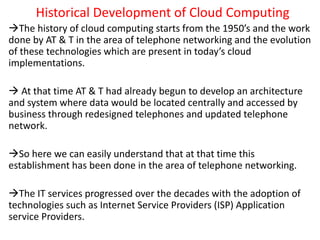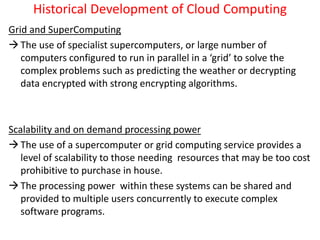Historical development of cloud computing
- 1. Historical Development of Cloud Computing The history of cloud computing starts from the 1950’s and the work done by AT & T in the area of telephone networking and the evolution of these technologies which are present in today’s cloud implementations. At that time AT & T had already begun to develop an architecture and system where data would be located centrally and accessed by business through redesigned telephones and updated telephone network. So here we can easily understand that at that time this establishment has been done in the area of telephone networking. The IT services progressed over the decades with the adoption of technologies such as Internet Service Providers (ISP) Application service Providers.
- 2. Historical Development of Cloud Computing One of the main principles of cloud computing from SAAS (Software as a service) to provide storage on demand, is that the computing capacity varies immediately and transparently with the customer’s need. Evolution of cloud technologies All of the following types of computing technologies and architectures share similarities with the benefits and architecture present in today’s cloud implementations:- Distributed Systems A distributed system is a collection of independent computers that appears to its users as a single system and also it acts as a single computer. The main and primary motive of distributed systems is to share resources and to utilize them better.
- 3. Historical Development of Cloud Computing This is absolutely true in case of cloud computing because in cloud computing we are sharing the single resource by paying rent. The resource is single because the definition of cloud computing clearly states that in cloud computing the single central copy of a particular software is stored in a sever (which is located on a anonymous location ) and users are accessing that on PAY PER USE BASIS. Mainframes and thin client computing It is highly reliable, powerful, centrally located form of computing service. A user of a mainframe system may access applications using a thin client(A thin client (sometimes also called a lean, zero or slim client) is a computer or a computer program that depends heavily on some other computer (its server) to fulfill its computational roles)). These classic green screen systems provides businesses with reliable and large scale processing power.
- 4. Historical Development of Cloud Computing Each mainframe system is designed to run at a high level of utilization without failure, and to support hardware up gradation. The mainframes can host multiple virtual instances of operating system and this is a crucial requirement for supporting scalability within cloud computing Utility Computing Computing services that can be metered and billed to customers in the same way that electricity or telephony system operate, are known as utility computing services. The concept of utility computing is also associated with the commercialization of problem solving in supercomputing systems.
- 5. Historical Development of Cloud Computing Grid and SuperComputing The use of specialist supercomputers, or large number of computers configured to run in parallel in a ‘grid’ to solve the complex problems such as predicting the weather or decrypting data encrypted with strong encrypting algorithms. Scalability and on demand processing power The use of a supercomputer or grid computing service provides a level of scalability to those needing resources that may be too cost prohibitive to purchase in house. The processing power within these systems can be shared and provided to multiple users concurrently to execute complex software programs.
- 6. Historical Development of Cloud Computing Web 2.0 The global presence of the internet and the introduction of wireless networking and mobile devices featuring always on internet connectivity has raised expectations of users and demand for services over the internet. Web 2.0 is the term given to describe a second generation of the World Wide Web that is focused on the ability for people to collaborate and share information online. Web 2.0 basically refers to the transition from static HTML Web pages to a more dynamic Web that is more organized and is based on serving Web applications to users. Other improved functionality of Web 2.0 includes open communication with an emphasis on Web-based communities of users, and more open sharing of information. Over time Web 2.0 has been used more as a marketing term than a computer-science- based term. Blogs, wikis, and Web services are all seen as components of Web 2.0.






